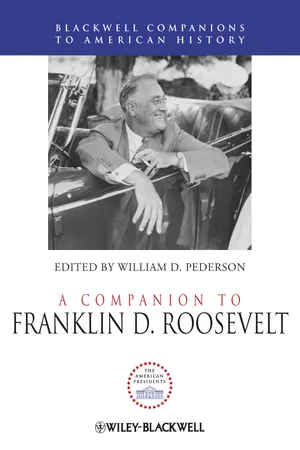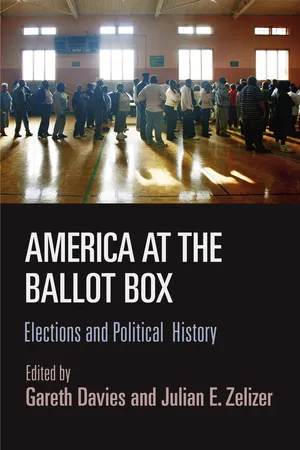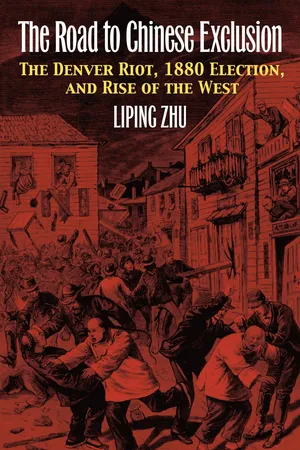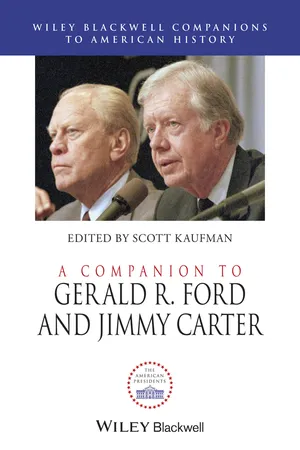History
1928 Presidential Election
The Presidential Election of 1928 in the United States saw Republican candidate Herbert Hoover defeat Democratic nominee Al Smith. Hoover's victory marked the continuation of Republican dominance in the White House, as he won by a significant margin. The election is notable for being the first time a Catholic, Al Smith, ran for president on a major party ticket.
Written by Perlego with AI-assistance
Related key terms
7 Key excerpts on "1928 Presidential Election"
- Katherine A.S. Sibley(Author)
- 2014(Publication Date)
- Wiley-Blackwell(Publisher)
Predictably, then, the election of 1920 was not close. The Republicans, after long negotiations at their convention, nominated Senator Warren G. Harding of Ohio, a man known mostly for his Republican reliability. The Democratic convention, meanwhile, was even more intensely divided, ultimately choosing another Ohioan, Governor James Cox, as its nominee (and former Assistant Secretary to the Navy Franklin Roosevelt as his running mate). The election, however, was largely about Wilson and the Democrats in general rather than Cox himself. Running on an explicitly anti-Wilson platform, Harding and his running mate Calvin Coolidge portrayed themselves as “anti-Wilsons,” appealing to the need for the country to return to “normalcy.” Harding “showed that he would not be an obstinate leader of the Wilson type and that he desired only to marshal the energies of the government to help business, labor, and agriculture get back on their feet” (Murray 1973: 9). It was, in other words, a call to a simpler (and arguably largely mythical) time, an appealing sentiment in a postwar, inflation- and unemployment-ridden economy. In the end, Harding won 61 percent of the popular vote, the largest percentage to that point in American history. Perhaps the most notable sign of the strength of his victory, however, came in the Electoral College count: Harding carried the state of Tennessee, the first time in forty years a Republican had won any state of the former Confederacy.More troubling for the Democrats was that the election of 1920 was neither a fluke nor a short-term victory. Republicans would remain in control of the presidency throughout the entirety of the 1920s, winning each election by consistently wide margins by “identif[ying] their party with the promise of peace and prosperity” and promoting “strong business/government cooperation that led to almost unbridled corporate power” (Dumenil 1995: 7). These Republican administrations are well worth historical study, but it is just as instructive to consider what was happening within the losing party. In this case, the Democratic Party was undergoing a significant and culturally important demographic shift. By the time Franklin Roosevelt returned the Democrats to the White House in 1932, the constituency of the Democratic Party looked much different than it had in 1920. Certainly, Roosevelt’s landslide victory was due primarily to American concerns and fears about the Great Depression and a lack of confidence in incumbent Herbert Hoover. But it was also the culmination of a shift in the Democratic Party, a shift with roots reaching back at least as far as 1920. The Democrats faced a “profound conflict” that year, one “variously described as a struggle between the country and the city, the nativist and the immigrant, the liturgical and the pietist” (Clark 1976: 182). In short, the Democrats were facing, among other things, a struggle between their more traditional native, white, southern constituents and the rising power of urban voters, often immigrants. Their interests often did not align, including on the subject of Prohibition.- eBook - ePub
Delivering the People's Message
The Changing Politics of the Presidential Mandate
- Julia R. Azari(Author)
- 2014(Publication Date)
- Cornell University Press(Publisher)
The partisanship, frequency, and defensiveness of Hoover’s mandate rhetoric resembled that of the partisan era that began forty years later. The emphasis on “pledge politics” and the use of the mandate to respond to challenging questions anticipated how a diverse group of later leaders—Nixon, Carter, Clinton, George W. Bush, and Obama—would employ mandate rhetoric. In contrast with Hoover’s successors who departed quickly from this mold of mandate claiming, presidents in the partisan era have employed it as a rhetorical norm. Political and institutional conditions account for this difference.Interpreting the 1932 Election
The historical significance of the 1932 election can hardly be mistaken. Herbert Hoover was turned out of office and his Democratic rival, Franklin Roosevelt, was elected with more than 57 percent of the popular vote. The new president offered a “New Deal,” which contained a mix of new and old ideas, packaged in terms of national values as well as economic necessity.51 Roosevelt also engineered changes in the Democratic Party’s nomination rules, was the first president inaugurated under the Twentieth Amendment (which moved Inauguration Day from March to January), and became the first (and last) president elected to more than two terms.In the evolution of mandate rhetoric, the FDR presidency was also a turning point. FDR neither embraced Wilson’s vision of the party mandate, nor did he use mandate logic frequently when promoting New Deal policies. Both the 1932 and 1936 elections could easily have qualified as party landslides, yet Roosevelt’s mandate rhetoric reveals a more complicated picture. In 1933, when his position was strong and national crisis bolstered the legitimacy of his initial agenda, mandate rhetoric was sparse. After the 1936 election, Roosevelt invoked the election mandate in the context of an institutional clash: the “court-packing” plan of 1937.Even with the Great Depression as a backdrop, the meaning of the 1932 election was contested. Newspapers offered a range of interpretations. The superintendent of the Anti-Saloon League, Scott McBride told the New York Times, “If the party misinterprets the election as a mandate for beer and a demand for repeal it need not hope to succeed. Most of the wet Democrats who won in this landslide were elected because they were Democrats and not because they were wets.”52 Coverage of the election offered a number of possibilities for its meaning: some emphasized the Democratic victory; some gave the numbers a central place in the narrative; and still others directed attention toward voter anger, suggesting a negative referendum on the incumbent administration rather than a positive one on Roosevelt or the Democrats.53 Charles Hurd reports in the New York Times that “7,000,000” cast their votes in favor of the New Deal and emphasizes both the magnitude of the victory and the party and policy implications of the result, suggesting that the “Democratic triumph entails an implied command to solve the problems of economic dislocation, of prohibition, and the foreign affairs of the United States as they are related to war debt and tariffs.”54 By contrast, the Wall Street Journal questions the partisan and ideological terms in which the victory had been cast by the president and sources sympathetic to him; an article with the subtitle “Strange Bedfellows Made Up the Mass Movement Which Elected Roosevelt” questions Roosevelt’s claim to a “victory of liberal thought” in the postelection radio address and further ponders the role of electoral majorities in the design of the Constitution.55 - eBook - ePub
- William D. Pederson(Author)
- 2011(Publication Date)
- Wiley-Blackwell(Publisher)
Chapter Five THE ELECTION OF 1932 Donald A. Ritchie The process of deciphering the 1932 election began as soon as the campaign had ended. It quickly became a truism that the Great Depression had doomed Herbert Hoover’s chances of reelection and paved the way for Franklin D. Roosevelt’s presidency. Less attention was therefore devoted to why Roosevelt won than on whether or not his campaign adequately prepared the nation for his New Deal agenda. By all accounts, the 1932 election marked a watershed in American politics. The Great Depression profoundly shook American voters, forcing them to reexamine their political allegiances and expectations for the federal government. After being the dominant political party since the Civil War, Republicans were dethroned and Democrats became the majority party for most of the next half century. Herbert Hoover, who had won the presidency in a landslide four years earlier, lost it in an even greater electoral avalanche. Franklin Roosevelt swept into the presidency promising a new deal for the American people. Democrats added 99 seats in the House and a dozen new senators to give them overwhelming control of Congress, and a readiness to follow the new president wherever he led, to get the nation out of the economic crisis. Citizens’ expectations for the federal government expanded and new programs more directly connected the government to their daily lives. The relevant literature began a year before the election when Ernest K. Lindley, a New York Herald Tribune reporter who covered Roosevelt as governor, published an influential campaign biography, Franklin D. Roosevelt: A Career in Progressive Democracy (1931: 7–8, 355). Lindley denied that Roosevelt had solicited him to write the book, but its sympathetic assessment helped to boost his candidacy. In a second edition, released after the election, Lindley added a chapter on the Democratic nomination, reminding readers that there had been nothing inevitable about that outcome - eBook - ePub
America at the Ballot Box
Elections and Political History
- Gareth Davies, Julian E. Zelizer(Authors)
- 2015(Publication Date)
- University of Pennsylvania Press(Publisher)
For scholars of American politics more generally, the national campaigns of the 1920s have occasioned little interest on their own terms. They draw attention mainly as fodder for debates over the preceding era—arguments over the persistence or collapse of Progressive reform—or as harbingers of future developments, such as the emergence of the New Deal coalition. Those latter interpretations focus on conflicts within the Democratic Party. While the Republicans nominated Coolidge practically by acclamation, the Democrats split badly. During the party’s 1924 convention—held in a roasting, unair-conditioned Madison Square Garden during a New York heat wave—the Democrats deadlocked for sixteen brutally hot days. Divided between its cosmopolitan, urban, ethnic wing, which opposed Prohibition and rallied behind Al Smith, the Roman Catholic governor of New York, who was of Irish immigrant stock, and the rural, Protestant, Prohibitionist southern and western bloc that supported William G. McAdoo, the two factions fought over whether to condemn the Ku Klux Klan and over who to nominate for president. Ballot after ballot dragged on for weeks, but the rival wings could not agree. On the 103rd ballot, after the main contenders had withdrawn, the still-divided party compromised on the bland Davis. Several historians have depicted the convention as a pivot, a point of equilibrium between the old Democratic Party, personified by McAdoo and William Jennings Bryan, and the New Deal coalition embodied by Smith and Franklin D. Roosevelt. In this view, the defeat of McAdoo and the nomination of an explicit critic of the Klan point toward the modern liberal, urban Democratic Party that would take shape a decade later.That argument owes its origins to Samuel Lubell’s classic study, The Future of American Politics . In that 1951 book, Lubell, a prominent pollster who had worked in federal agencies during World War II, suggested that Al Smith’s unsuccessful presidential runs during the 1920s had planted the seeds for the assembly of the New Deal coalition and for an era of Democratic Party dominance in American politics. In particular, Lubell stressed growing Democratic strength in the nation’s cities. In 1920 the Republicans swept the nation’s twelve largest cities by a million and a half votes. Eight years later, however, the Democrats won the urban vote. Of course, this forward-looking account emphasized 1928 and Smith’s presence on the top of the ticket, an election where the Democrats carried the big cities but lost a significant chunk of the “Solid South.”16In recent years, political historians have refined and deepened this notion of the 1920s as incubator of modern American politics, seeing the period as herald not merely of imminent shifts in partisan affiliation but of broader changes in the style and structure of American politics. Brian Balogh casts the decade as the critical juncture in a half-century-long transformation from a politics of parties to a politics of interests. For Balogh, however, as for Lubell, the decisive shift does not arrive until Herbert Hoover’s 1928 presidential campaign. Unlike his predecessors, Hoover “rose to power outside of the party structure” and “was more beholden to interest group cues than partisan intelligence for his connection to voters.”17 - Elizabeth Stevenson(Author)
- 2017(Publication Date)
- Routledge(Publisher)
Davis was less easy to understand than his contemporaries who were romantic about the realistic American scene, but he was to wear as well or better. His pictures would hang comfortably side by side twenty years later with the paintings of the “New York School.” He reached back to Robert Henri and forward to Jackson Pollock.It was in this incongruous new America of scholarship and art that the garish, simpleminded political campaign of Herbert Hoover and Al Smith in 1928 was played out. The political life of the nation had deteriorated to a vestigial state. Every other part of its life had become complex and varied. The Government of the great nation, at least in the lesser offices in state, county, and city, was given over to fools, rascals, or good little men of limited imagination. The real interest of the people was turned elsewhere. In business, communicating, transporting, and organizing, in certain kinds of research, in a number of the arts, Americans had a zest for complication, for real questions and real answers. Only in politics they made no effort except sporadically and often in flurries of prejudice, so eventually they did not rule themselves, and the splendid acceleration of effort and enjoyment in which they were wound up slowed down and toppled over.But a major political campaign stirred up public interest for a few months. On June 12, 1928, the Republican Party opened its national presidential convention in the great Main Street city, Kansas City, and on the first ballot nominated as their candidates for president and vice-president, respectively, Herbert Clark Hoover, Secretary of Commerce under Harding and Coolidge since 1920, and Charles Curtis, Republican Senator from Kansas. The Democratic Party convened in Houston, Texas, on June 26, and on the first ballot nominated Alfred E. Smith, Governor of New York for president, and Senator J. T. Robinson of Arkansas for vice-president. Hoover and Smith represented clear-cut differences, but the campaign as conducted blurred the distinctions.In general the voter was not ready for a sharp clash of issues. Hoover’s political doctrine was orthodox: When business prospered, the rest of the country was assured of prosperity. His statement of these beliefs was lackluster and conventional, but his recent activities during the Mississippi flood lent him an aura of glamor that was foreign to his character but helped his campaign.- eBook - ePub
The Road to Chinese Exclusion
The Denver Riot, 1880 Election, and Rise of the West
- Liping Zhu(Author)
- 2014(Publication Date)
- University Press of Kansas(Publisher)
CHAPTER 3
THE ELECTION OF 1880
The presidential election of 1880 is one of the most overlooked and underappreciated national political contests in American history. “The campaign of 1880,” one historian claims, “was barren of issues and devoid of drama.” Another simply calls it “a dull affair.”1 Given more scrutiny, however, this little-known election actually lacked neither excitement nor substance. Ulysses S. Grant, who wanted to move into the White House yet again, broke a sacred tradition and sought his party’s nomination in hopes of winning a third term. After failing to procure the party nomination, Grant continued to campaign fervently for the Republican nominee, James A. Garfield, for the sake of party unity. President Rutherford B. Hayes, the incumbent, who had decided not to run for a second term, took two months to travel across the continent and actively stump for his fellow Ohioan on the Pacific Coast. On his tour, Hayes became the first sitting president to visit the far West. This fast-growing region had complicated the politics of American sectionalism and demanded more power. Because the North-South hatred remained deep, the bloody-shirt strategy still roused voters everywhere. Some fresh issues, such as economic protectionism, civil service reform, and Chinese immigration restriction, further energized the people. More dramatically, an “October surprise” involving forgery and accusation nearly altered the outcome of the election. In the election, 79.4 percent of eligible voters cast their ballots, resulting in one of the highest voter turnouts in history. Out of more than 9.2 million votes, the winner carried a majority of only 9,070, or less than 0.1 percent. For many reasons, this election is far more fascinating and consequential than most people realize.2Although marking the end of the bitterly contested Reconstruction of the South, the Compromise of 1877 did not bring a new era of good feelings. Nothing could alleviate the national anguish over the most controversial presidential election, in which Rutherford B. Hayes (R) had claimed victory over Samuel J. Tilden (D) by a single electoral vote. This result was secured only by a special electoral commission, which awarded Hayes nineteen disputed votes from three Southern states. Convinced that the Republican Party had truly “stolen” the presidency, Democrats gave Hayes the title of “His Illegitimacy” and immediately prepared for a rematch, just as Andrew Jackson’s supporters had done after the “Corrupt Bargain.” President Hayes pledged a more conciliatory policy toward the South and hoped to restore the two-party system in the region. But Southern Democrats refused to share power with Republicans as they consolidated their political gains through fraud and terrorism. To Republicans, the “Solid South,” a phrase associated with the region’s one-party rule, was the real threat to American democracy. To do away with corrupt political patronage, the progressive Hayes favored civil service reform, which made him a divisive figure in his party. Many Republicans wanted a different commander-in-chief who would be tough on the Southern “redeemers” and soft on federal reform. Almost from the beginning of Hayes’s administration, therefore, both Republicans and Democrats looked forward to another presidential election, or round two of ’76.3 - eBook - ePub
- Scott Kaufman(Author)
- 2015(Publication Date)
- Wiley-Blackwell(Publisher)
Chapter Twenty-Six The Election of 1980 Andrew E. Busch The election of 1980 pitted Jimmy Carter against Massachusetts Senator Edward M. Kennedy and California Governor Edmund “Jerry” Brown in the Democratic primaries and caucuses, and Carter against former California Governor Ronald Reagan and Republican-turned-Independent Congressman John Anderson of Illinois in the general election. Down in the polls in the summer of 1979, Carter won his renomination against Kennedy and Brown, only to fall in the general election to Reagan. Indeed, despite a campaign during which the two major candidates seemed to be running neck and neck, Reagan won 51 percent of the nationally-aggregated popular vote in a three-way race, attaining a ten-percentage-point margin over Carter. In the Electoral College, Reagan’s win was even more decisive, with the former California governor winning all but six states and the District of Columbia and outpacing Carter 489 to 49 in electoral votes. Anderson finished with 7 percent nationally, far less than he had polled in September but enough to receive federal election funds in 1980 and (if he ran again) 1984. Reagan’s victory was accentuated by big Republican gains in Congress, raising questions whether 1980 represented an ideological mandate for Reagan or even the beginning of a realignment. The Political Context When British political scientist Anthony King edited The New American Political System (1978b), he and the other contributors sketched a comprehensive picture of the political environment, especially institutional, within which the election of 1980 would take place. Samuel Beer, for example, argued that the New Deal idea had ceased to serve as a unifying principle in American politics but that a new dominant “public philosophy” had yet to emerge
Learn about this page
Index pages curate the most relevant extracts from our library of academic textbooks. They’ve been created using an in-house natural language model (NLM), each adding context and meaning to key research topics.






